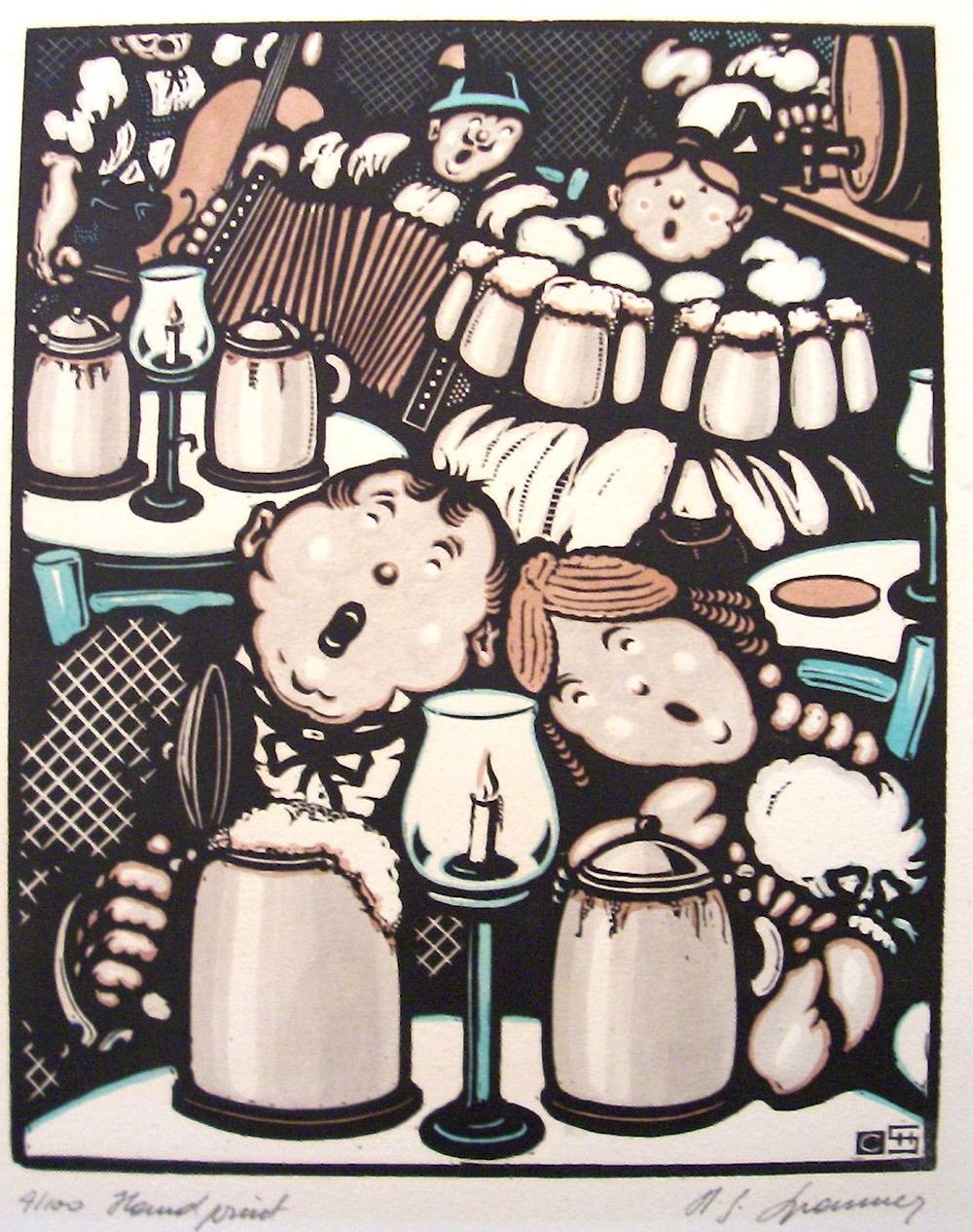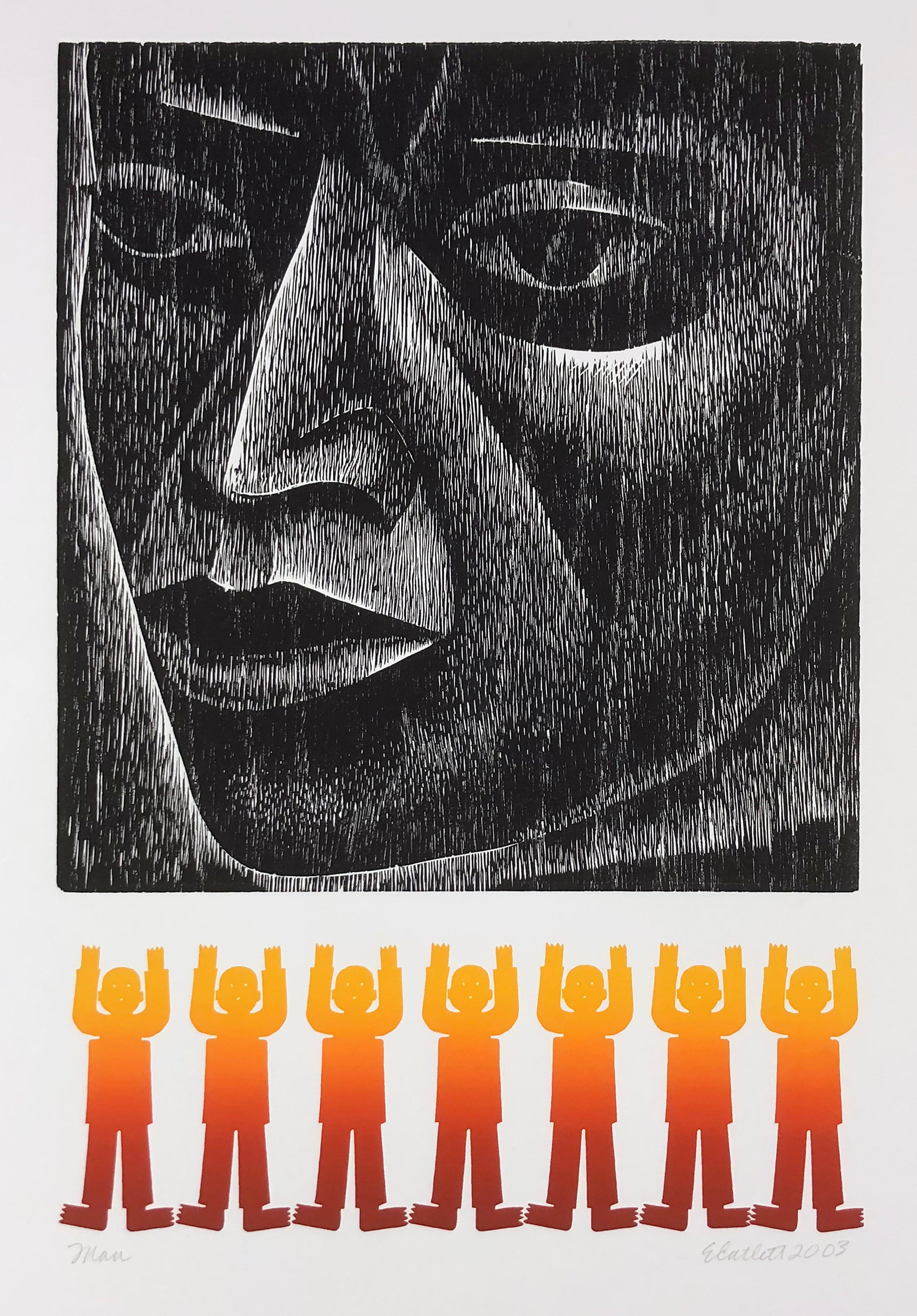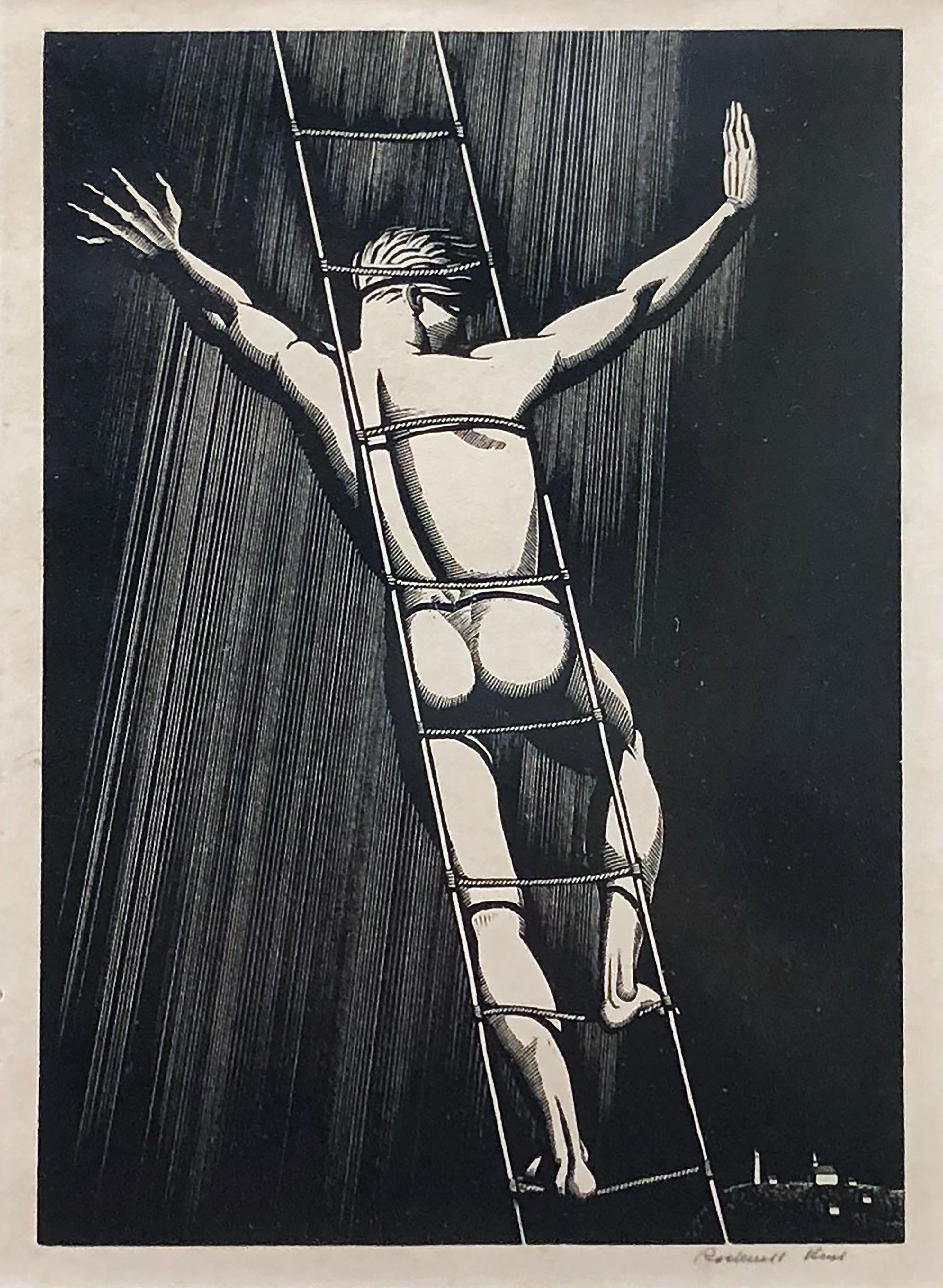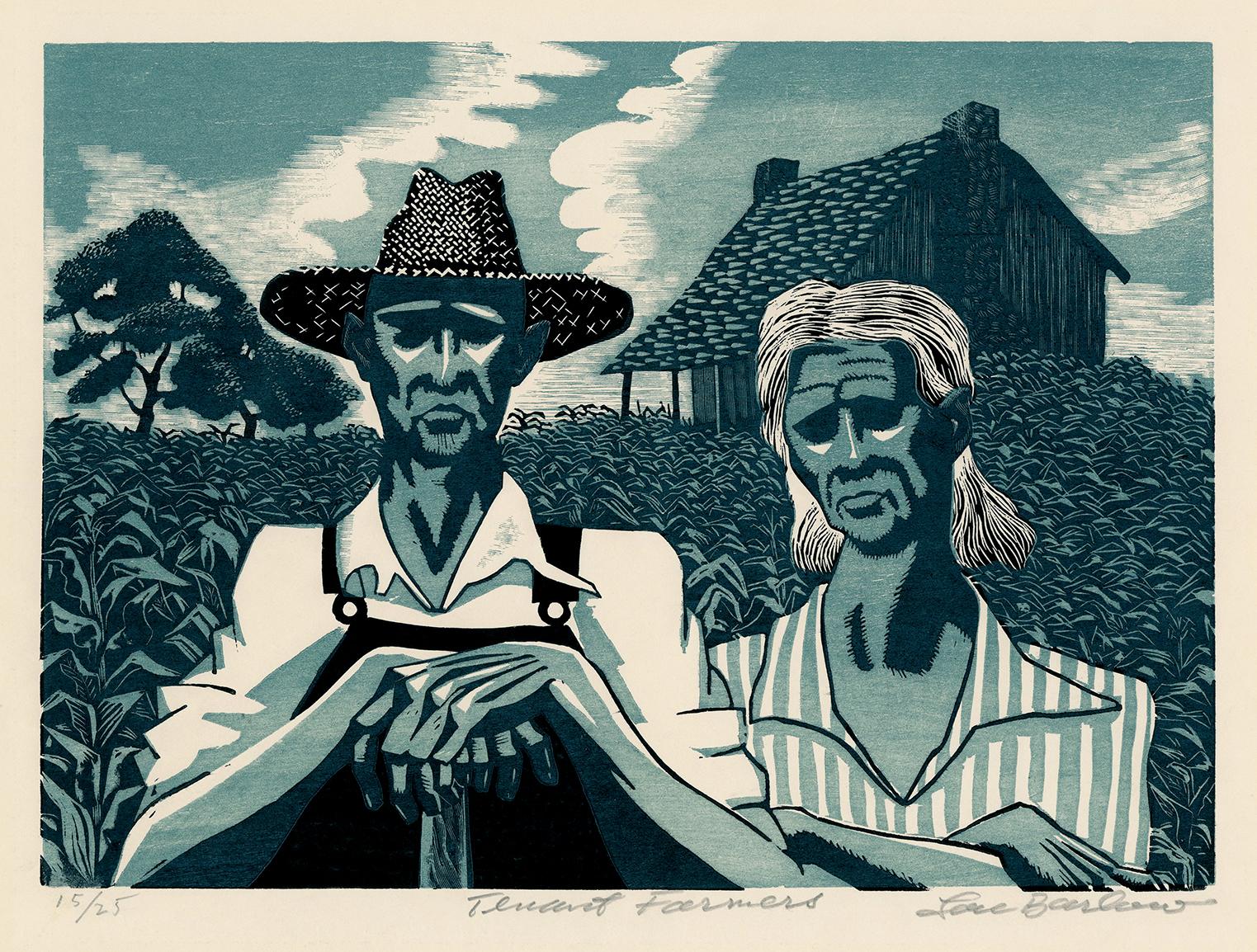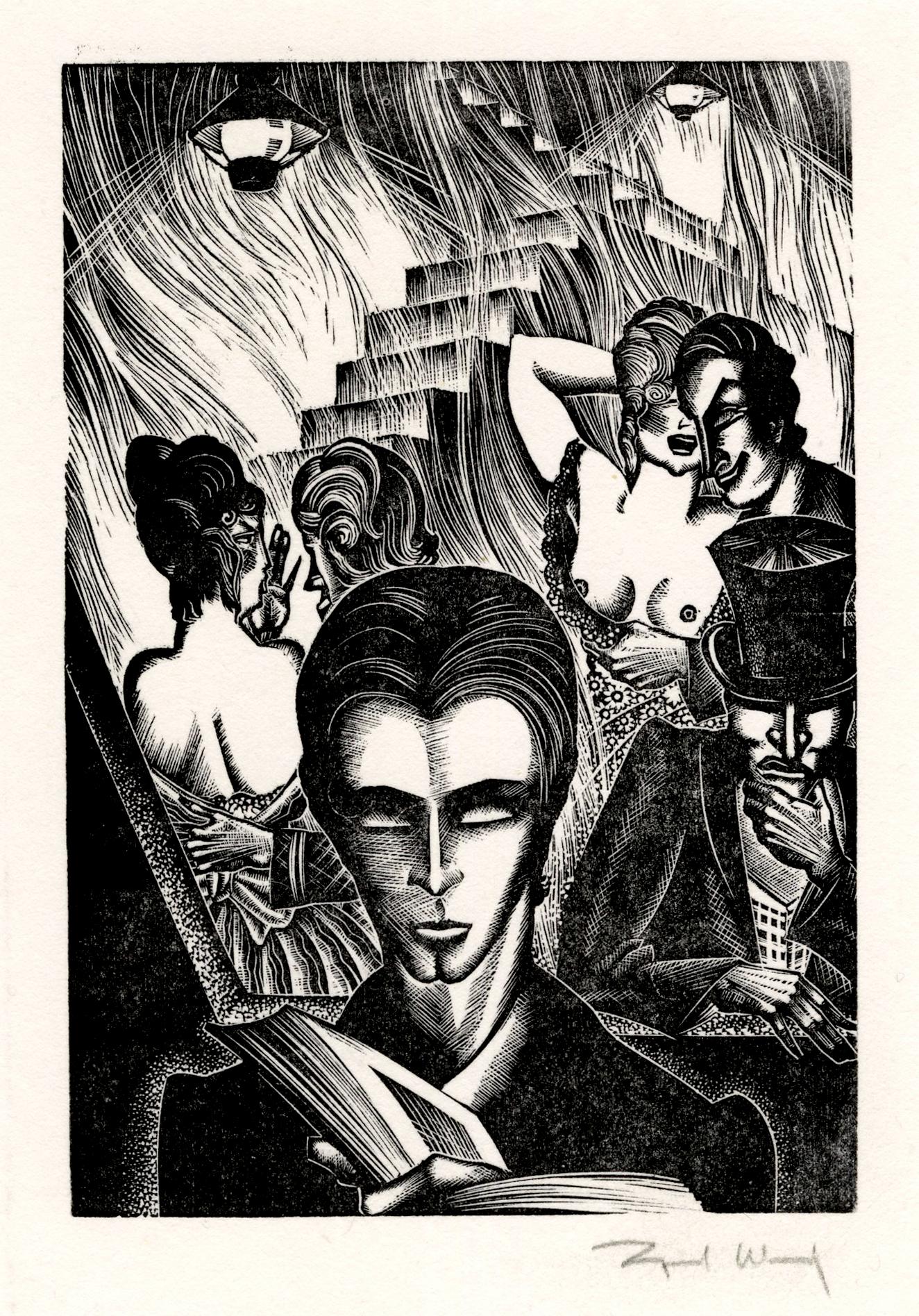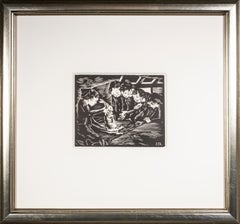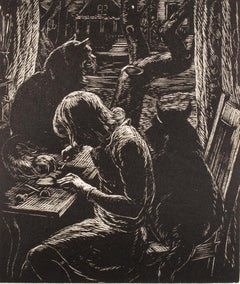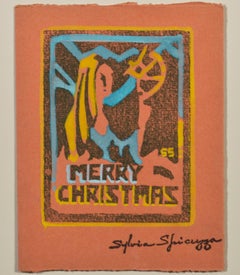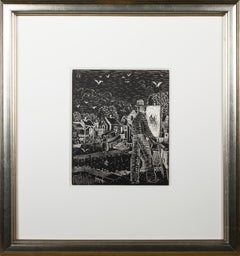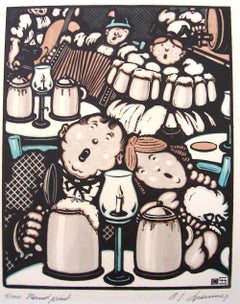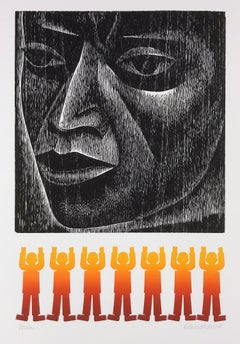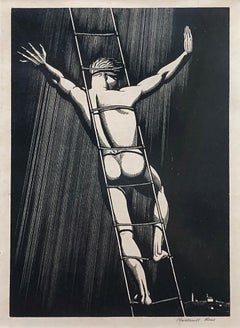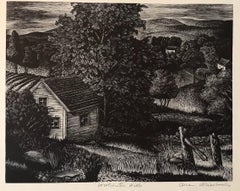Items Similar to 20th century woodcut ink black and white figures musical instruments dramatic
Want more images or videos?
Request additional images or videos from the seller
1 of 9
Robert Franz Von Neumann20th century woodcut ink black and white figures musical instruments dramatic1937
1937
About the Item
"Chamber Music" is an original wood engraving by Robert Franz von Neumann. It features a room full of men in the thralls of creating music together. A small audience stands outside their circle.
Image: 5.5" x 7"
Framed: 14" x 15.56"
1888 - 1976 Born in Rostock, Mecklenburg, Germany, Robert von Neumann was a painter, lithographer, engraver, block printer, and teacher. He served in the German Army during WWI and after, between the years 1910-1914, he studied art at the Kunstgewerbe Schule in Rostock, and then at the Royal Academy and Kunstgewerbe Museum in Berlin. He also studied under painters Hans Hofmann, Emile Topler, and Frans Burke. In 1926, von Neumann came to America and decided to settle in Wisconsin because the landscape reminded him of his homeland in Germany. Arriving in Milwaukee, his first jobs were working for a commercial printing company and at the Milwaukee Journal as a part of the Art staff. In 1929, von Neumann began what became a 30-year career teaching art at the Layton School of Art in Milwaukee from 1929-1930, before moving on to the Milwaukee State Teachers College. He also taught at the Ox-Bow Summer School of Painting, in Saugatauk, Michigan, and later at the Art Institute of Chicago. Robert von Neumann is best known for his images of robust working men, engaged in everyday tasks, such as mending fishing nets, harvesting apples, or breaking for lunch or supper together. His art belongs to the Regionalist movement in American art, best known for the art of John Stuart Curry, Thomas Hart Benton, and Grant Wood. These artists wished to celebrate everyday people and their relationship with the land, and much of their subject matter also seems to be a snapshot of everyday life, seemingly mundane moments that reveal the underlying spirit of a person in his or her environment. Von Neumann's deep connection with and respect for nature is evident in his painting Shanty and Boats on the Shore, (1930) depicting the Lake Michigan shoreline near Milwaukee. Here his mastery of translating the effects of outdoor light onto the canvas with clear and bright colors and bold brushstrokes is evidence of his keen observation of the spirit of a place and a moment, as well as his German art education and meticulous draftsmanship. The focus on the small shanty and the boats on the shore remind the viewer of the work of the men and women that live there, even though they are not seen. The bright colors of the boats' hulls and the dappled sunlight falling through the trees also convey a sense of the peacefulness of the place, as if one can hear the gentle breaking of the waves on the beach and the cries of gulls. This painting is a superb example of von Neumann's skill at evoking the mood of a sunny day on the Lake Michigan shore, as well as his command of the brush and paint. Robert von Neumann died in 1976 in West Bend, Wisconsin. Selected One -Person Exhibitions: 1941 Art Institute of Chicago, Illinois 1944 Pennsylvania Academy of Fine Arts, Philadelphia 1960 and 1972 Milwaukee Art Center, Wisconsin (now the Milwaukee Art Museum) The artwork of Robert von Neumann is in the following permanent collections: West Bend Art Museum, West Bend, WI Wisconsin Union Art Collection, Madison, WI Milwaukee Art Museum, Milwaukee, Wisconsin Library of Congress, Washington, D.C. Bibliotheque Nationale, Paris, France American Institute of Graphic Arts Fine Arts Museums of San Francisco, Legion of Honor Recipient of the 2007 Wisconsin Visual Artist Lifetime Achievement Award
- Creator:Robert Franz Von Neumann (1888 - 1976)
- Creation Year:1937
- Dimensions:Height: 14 in (35.56 cm)Width: 15.56 in (39.53 cm)
- Medium:
- Movement & Style:
- Period:
- Condition:
- Gallery Location:Milwaukee, WI
- Reference Number:Seller: 13967g1stDibs: LU60534932561
About the Seller
4.9
Gold Seller
Premium sellers maintaining a 4.3+ rating and 24-hour response times
Established in 1966
1stDibs seller since 2017
429 sales on 1stDibs
Typical response time: 2 hours
- ShippingRetrieving quote...Shipping from: Milwaukee, WI
- Return Policy
Authenticity Guarantee
In the unlikely event there’s an issue with an item’s authenticity, contact us within 1 year for a full refund. DetailsMoney-Back Guarantee
If your item is not as described, is damaged in transit, or does not arrive, contact us within 7 days for a full refund. Details24-Hour Cancellation
You have a 24-hour grace period in which to reconsider your purchase, with no questions asked.Vetted Professional Sellers
Our world-class sellers must adhere to strict standards for service and quality, maintaining the integrity of our listings.Price-Match Guarantee
If you find that a seller listed the same item for a lower price elsewhere, we’ll match it.Trusted Global Delivery
Our best-in-class carrier network provides specialized shipping options worldwide, including custom delivery.More From This Seller
View All'The Rabbit' original woodcut engraving by Clarice George Logan
By Clarice George Logan
Located in Milwaukee, WI
In 'The Rabbit,' Wisconsin artist Clarice George Logan presents the viewer with a multi-figural scene: under a wood-frame structure, four children crouch on the ground, gathered around a young woman who presents a rabbit. Under normal circumstances, such an image of children with a bunny would recall childhood storybooks. In this case, however, the image is more ambiguous and suggests the unfortunate economic circumstances many children suffered during the interwar years. Nonetheless, the group could also be interpreted as a nativity play, with the rabbit taking the place of the Christ child, shining light on the children like in a painting by the Italian Renaissance artist Correggio. The careful line-work of the woodblock engraving adds a sense of expressionism to the scene, leaving the figures looking distraught and dirty, though the image nonetheless falls into the Social Realist category that dominated American artists during the Great Depression.
This print was published in 1936 as part of the Wisconsin Artists' Calendar for the year 1937, which included 52 original, hand-made prints - one for each week of the year.
Clarice George Logan was born in Mayville, New York in 1909 but moved to Wisconsin in 1921. She attended the Milwaukee State Teachers College from 1927 to 1931 where she studied with Robert von...
Category
1930s American Modern Figurative Prints
Materials
Engraving, Woodcut
"Angelika's Pets, " Wood Engraving by Robert Franz Von Neumann
By Robert Franz Von Neumann
Located in Milwaukee, WI
"Angelika's Pets" is an original wood engraving by Robert Franz Von Neumann. It features a young woman sitting at a desk, working on a wood engraving. Two large cats sit near her and look out a window nearby.
Image: 6" x 5"
Framed: 13.43" x 12.43"
1888 - 1976 Born in Rostock, Mecklenburg, Germany, Robert von Neumann...
Category
1930s American Modern Figurative Prints
Materials
Woodcut
"Merry Christmas, " Original Color Woodcut signed with stamp by Sylvia Spicuzza
By Sylvia Spicuzza
Located in Milwaukee, WI
"Merry Christmas" is an original color woodcut on paper by Sylvia Spicuzza. The artist stamped her signature lower right. This artwork features the an abstracted figure on orange p...
Category
1950s American Modern Figurative Prints
Materials
Woodcut
'Jones Island' original woodcut engraving by Gerrit Sinclair
By Gerrit Sinclair
Located in Milwaukee, WI
The print 'Jones Island' is something of a self portrait. In the image, an artist stands before and easel, depicting the docks and buildings on the coast. The title indicates that this is Jones Island in Milwaukee, the peninsula along Lake Michigan that today is home to largely industrial buildings. The buildings and figures in the print suggest that this might be a view of the last of the Kashubian or German immigrant settlements on the peninsula before they were evicted in the 1940s to make way for the development of the harbor. The artist in the image thus acts as a documentarian of these peoples. The careful line-work of the woodblock engraving adds a sense of expressionism to the scene, leaving the figures and buildings looking distraught and dirty, though the image nonetheless falls into the Social Realist category that dominated American artists during the Great Depression.
This print was published in 1936 as part of the Wisconsin Artists' Calendar for the year 1937, which included 52 original, hand-made prints – one for each week of the year.
6 x 5 inches, image
10 x 7.13 inches, sheet
13.43 x 12.43 inches, frame
Signed "GS" in the print block,upper left
Entitled "Jones Island" lower left (covered by matting)
Inscribed "Wood Engraving" lower center (covered by matting)
Artist name "Gerrit V. Sinclair" lower right (covered by matting)
Framed to conservation standards using 100 percent rag matting and museum glass, all housed in a silver gilded moulding.
Gerrit Sinclair studied at the Art Institute of Chicago from 1910 - 1915, under Vanderpoel, Norton, and Walcott. In World War I, he served in the Army Ambulance Corps and later recorded his experiences in a series of oil paintings. He taught in Minneapolis before arriving in Milwaukee in 1920 to become a member of the original faculty of the Layton School of Art. He was also a member of the Wisconsin Painters & Sculptors.
Sinclair's paintings and drawings were executed in a lyrical, representational style, usually expressing a mood rather than a narrative. His paintings reveal a great sensitivity for color and atmosphere. His subject matter focused on cityscapes, industrial valleys, and working-class neighborhoods, captured from eye-level. A decade before the popularity of Regionalism, Sinclair's strong interest in the community was reflected not only in his paintings, but also in his encouragement to students to return to their communities as artists and teachers. Joseph Friebert...
Category
1930s American Modern Figurative Prints
Materials
Engraving, Woodcut
"Victoria" original lithograph signed by Malvin Marr "Zsissly" Albright
By Malvin Marr Albright
Located in Milwaukee, WI
The present print, "Victoria," is the most iconic example of the printmaking of Malvin Marr Albright, called Zsissly. The composition for the image comes from Albright's painting from about 1935, done while he was studying at the Art Institute of Chicago. We can see clearly in the image how he possesses the same skill for unsettling, magic realist images as his more famous twin brother Ivan Le Lorraine: The lady Victoria sits at a dining room table, surrounded by luxurious still-life objects. All the textures and surfaces of the image express a horror vacui as seen in his painted works, such as "The Trail of Time is Dust" at the Pennsylvania Academy of Fine Art. The door in this print recalls one of the more famous works by his brother, "That Which I Should Have Done I Did Not Do (The Door)" at the Art Institute of Chicago.
1947, after ca. 1935 original painting
8 1/2 x 13 inches, image
12 x 16 inches, sheet
16 1/4 x 20 1/2 frame
Signed in pencil, lower right
Title in pencil, lower left
Published by Associated American Artists Inc.
Unnumbered from the edition of 250
A painter and sculptor, Malvin Albright was born in Chicago, one of twin sons of Adam Emory Albright, famous Chicago figure painter of juvenile subjects, who often used Malvin and his brother Ivan Le Lorraine as models.
Malvin's middle name, Marr, was after Wisconsin artist Carl von Marr...
Category
1940s American Modern Figurative Prints
Materials
Lithograph
'Lobsterman's Wharf, Maine' original lithograph signed by "Zsissly" Albright
By Malvin Marr Albright
Located in Milwaukee, WI
'Lobsterman's Wharf, Maine' is an original lithograph signed by Malvin Marr "Zsissly" Albright. While Malvin Marr – along with his better-known identical twin Ivan Albright – was known for his meticulous and unsettling magic realist compositions, he and his brother were also prolific in capturing landscapes of the coast of Maine where the two spent several consecutive summers away from Chicago over their lives. Sometimes these Maine landscapes and views would be painterly and seemingly antithetical to the careful realism of his other work; but in this example, however, the wharf is treated with the same macabre decay as his human subjects. In the composition, the shack...
Category
1940s American Modern Figurative Prints
Materials
Lithograph
You May Also Like
Henry Spanner, Beer
Located in New York, NY
This is among the very few prints known by Spanner. It's the epitome of joie de vivre. It is signed, numbered, and annotated 'Hand print,' in pencil. The numbering indicates an edit...
Category
1930s American Modern Figurative Prints
Materials
Woodcut
Man
By Elizabeth Catlett
Located in Missouri, MO
Elizabeth Catlett
“Man” 1975 (The Print Club of Cleveland Publication Number 83, 2005)
Woodcut and Color Linocut
Printed in 2003 at JK Fine Art Editions Co., Union City, New Jersey
Signed and Dated By The Artist Lower Right
Titled Lower Left
Ed. of 250
Image Size: approx 18 x 12 inches
Elizabeth Catlett (1915-2012) is regarded as one of the most important women artists and African American artists of our time. She believed art could affect social change and that she should be an agent for that change: “I have always wanted my art to service black people—to reflect us, to relate to us, to stimulate us, to make us aware of our potential.” As an artist and an activist, Catlett highlighted the dignity and courage of motherhood, poverty, and the working class, returning again and again to the subject she understood best—African American women.
The work below, entitled, “Man”, is "carved from a block of wood, chiseled like a relief. Catlett, a sculptor as well as a printmaker, carves figures out of wood, and so is extremely familiar with this material. For ‘Man’ she exploits the grain of the wood, allowing to to describe the texture of the skin and form vertical striations, almost scarring the image. Below this intense, three-dimensional visage parades seven boys, printed repetitively from a single linoleum block in a “rainbow roll” that changes from gold to brown. This row of brightly colored figures with bare feet, flat like a string of paper dolls, raise their arms toward the powerful depiction of the troubled man above.”
Biography:
Elizabeth Catlett (1915-2012)
Known for abstract sculpture in bronze and marble as well as prints and paintings, particularly depicting the female figure, Elizabeth Catlett is unique for distilling African American, Native American, and Mexican art in her work. She is "considered by many to be the greatest American black sculptor". . .(Rubinstein 320)
Catlett was born in Washington D.C. and later became a Mexican citizen, residing in Cuernavaca Morelos, Mexico. She spent the last 35 years of her life in Mexico.
Her father, a math teacher at Tuskegee Institute in Alabama, died before she was born, but the family, including her working mother, lived in the relatively commodious home of his family in DC. Catlett received a Bachelor of Arts degree from Howard University, where there was much discussion about whether or not black artists should depict their own heritage or embrace European modernism.
She earned a Master of Fine Arts degree in 1940 from the University of Iowa, where she had gone to study with Grant Wood, Regionalist* painter. His teaching dictum was "paint what you know best," and this advice set her on the path of dealing with her own background. She credits Wood with excellent teaching and deep concern for his students, but she had a problem during that time of taking classes from him because black students were not allowed housing in the University's dormitories.
Following graduation in 1940, she became Chair of the Art Department at Dillard University in New Orleans. There she successfully lobbied for life classes with nude models, and gained museum admission to black students at a local museum that to that point, had banned their entrance. That same year, her painting Mother and Child, depicting African-American figures won her much recognition.
From 1944 to 1946, she taught at the George Washington Carver School, an alternative community school in Harlem that provided instruction for working men and women of the city. From her experiences with these people, she did a series of paintings, prints, and sculptures with the theme "I Am a Negro Woman."
In 1946, she received a Rosenwald Fellowship*, and she and her artist husband, Charles White, traveled to Mexico where she became interested in the Mexican working classes. In 1947, she settled permanently in Mexico where she, divorced from White, married artist Francisco Mora...
Category
Late 19th Century American Modern Figurative Prints
Materials
Linocut, Woodcut
Price Upon Request
Hail and Farewell
By Rockwell Kent
Located in Missouri, MO
Rockwell Kent
"Hail and Farewell" 1930
Wood Engraving on Paper
Signed in Pencil Lower Right
Sheet Size: 14 3/8 x 11 1/4 in.
Image Size: 8 x 5 1/2 in.
Framed Size: 17.5 x 13.5 in.
Growing up in a genteel family in New York City, Rockwell Kent was a member of the rugged realist school of landscape painters as well as a popular illustrator and printmaker. His 1930 illustrations for Moby Dick are among his most lasting achievements. He was the first American artist to have work exhibited in the Soviet Union, a reflection of his Communist Party sympathies, which earned him the Lenin Peace Prize in 1967. This espousal of radical politics caused his career to suffer badly in the '50s because his leftist views caused him disdain among many Americans. However, his work, reflecting both realism and modernism, has earned increasing attention from American art historians.
His subject matter is wide-ranging including scenes of Maine's Monhegan Island, the Adirondack Mountains, book illustrations, and commercial art renderings for companies including General Electric, Rolls Royce, and Westinghouse. Although his first love was painting, in addition to illustration, he also did fabric, ceramic, and jewelry designs, and spent time as a dairy farmer, carpenter, home builder, and lobster fisherman...
Category
1930s American Modern Figurative Prints
Materials
Woodcut
Price Upon Request
Oscar Weissbuchm Westchester Hills (NY), WPA-era wood engraving
Located in New York, NY
New York City native Oscar Weissbuch (1904-1948), attended the Yale University School of Fine Arts and the Art Students League, NY. He participated in the NYC-WPA printmaking project...
Category
1930s American Modern Landscape Prints
Materials
Woodcut
'Tenant Farmers' — Depression Era, WPA
By Lou Barlow
Located in Myrtle Beach, SC
Lou Barlow (Louis Breslow), 'Tenant Farmers', color wood engraving, 1936, edition 25. Signed, titled, and numbered '15/25' in pencil. A superb, richly-inked impression, with fresh c...
Category
1930s American Modern Figurative Prints
Materials
Woodcut
Madman's Drum (Brothel) — 'Story Without Words' Graphic Modernism
By Lynd Ward
Located in Myrtle Beach, SC
Lynd Ward, 'Madman's Drum, Plate 41', wood engraving, 1930, edition small. Signed in pencil. A fine, richly-inked impression, on off-white tissue-thin Japan paper; the full sheet with margins (1 5/8 to 2 1/2 inches); a small paper blemish in the upper right margin, away from the image, otherwise in excellent condition. A scarce, artist-printed, hand-signed proof impression before the published edition. Matted to museum standards, unframed.
Image size 5 1/2 x 3 3/4 inches (140 x 95 mm); sheet size 9 5/8 x 7 1/8 inches (244 x 181 mm).
From Lynd Ward’s book of illustrations without words, 'Madman’s Drum', Jonathan Cape and Harrison Smith, New York, 1930.
Reproduced in 'Storyteller Without Words, the Wood Engravings of Lynd Ward', Harry N. Abrams, New York, 1974.
ABOUT THE ARTIST
Lynd Ward is acknowledged as one of America’s foremost wood engravers and book illustrators of the first half of the twentieth century. His innovative use of narrative printmaking as a stand-alone storytelling vehicle was uniquely successful in reaching a broad audience. The powerful psychological intensity of his work, celebrated for its dynamic design, technical precision, and compelling dramatic content, finds resonance in the literature of Poe, Melville, and Hawthorne. Like these classic American writers, Ward was concerned with the themes of man’s inner struggles and the role of the subconscious in determining his destiny. An artist of social conscience during the Great Depression and World War II, he infused his graphic images with his unique brand of social realism, deftly portraying the problems that challenged the ideals of American society.
The son of a Methodist preacher, Lynd Ward, moved from Chicago to Massachusetts at an early age. He graduated from the Teachers College of Columbia University, New York, in 1926, where he studied illustration and graphic arts. He married May Yonge McNeer in 1936 and left for Europe for their honeymoon in Eastern Europe. After four months, they settled in Leipzig, where Ward studied at the National Academy of Graphic Arts and Bookmaking. Inspired by Belgian expressionist artist Frans Masereel's graphic novel ‘The Sun,’ and another graphic novel by the German artist Otto Nückel, ‘Destiny,’ he determined to create his own "wordless" novel. Upon his return to America, Ward completed his first book, ‘God's Man: A Novel in Woodcuts,’ published in 1929. ‘Gods’ Man’ was a great success for its author and publisher and was reprinted four times in 1930, including a British edition. This book and several which followed it, ‘Madman’s Drum,’ 1930, ‘Wild Pilgrimage...
Category
1930s American Modern Figurative Prints
Materials
Woodcut
